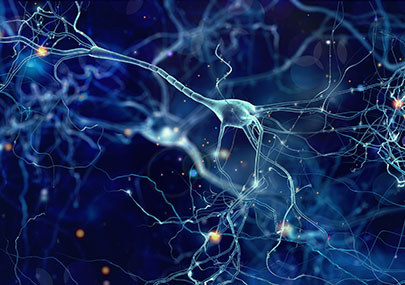Curriculum overview
This unit introduces secondary students to the concepts of pain, pain treatment, opioids, and the opioid crisis with 5 instructional modules including a creative project delivered to students through an interactive notebook format. It is designed with middle school students in mind, but can easily be adapted for high school audiences. The activities in the interactive notebook seek to educate youth about opioids as a tool for pain management when used under the direction of a physician, to raise awareness about the risks of opioid misuse and addiction, and to provide youth with the opportunity to use their voices to take action and educate others about the Opioid Crisis.
What students learn
The unit provides a basic overview of the nervous system and engages students in exploring the sensation of pain as a function of the nervous system. Next students learn about opioids, their use to manage pain, and how they function in the body and brain. They then transition into learning about the opioid crisis in the United States, exploring issues of misuse, addiction, and prevention. The unit ends with a creative project in which students take what they have learned to develop educational materials for peer audiences.


Who the materials are designed for
These materials are designed for use in Middle School health classes, particularly for 7th and 8th grade. The Brain and Nervous System activities are also aligned with NGSS Life Sciences standards. Teachers can adapt and use the whole unit, individual modules, or even individual activities and resources from within the modules. The broad scope of the materials is designed to provide teachers with choices and multiple pathways. While we hope teachers and students find value in all the materials, we do not expect that every teacher will have every student complete each activity. High school teachers can use many of the same materials and add complexity to prompts and activities as needed to increase the academic rigor and depth of knowledge needed for different tasks.
The following driving questions guide student learning across the whole unit:
How can something that is supposed to help you hurt you? What are opioids, how and why are they used, and why is there a crisis related to their use?
What makes a problem a national crisis, and how can I help make a national crisis better?
In addition, students will explore the following supporting questions:
What is pain? Why and how does pain happen? What is the physiology of pain?
How does understanding the nature and physiology of pain help us treat it?
What are the different ways to treat pain?
What are the benefits and risks of different pain treatments?
What are opioids and how are they used in medicine?
What are the risks of opioids? What is opioid misuse? What is opioid addiction and why is it such a problem?
What are solutions to opioid misuse and addiction?
What is the opioid crisis, and how can I help make it better?
In this process, students will have the opportunity to develop the following core understandings:
The nervous system has three primary components: the brain, the spinal cord, and nerves.
Nerve cells, also called neurons, send messages across neural networks to help the body process and respond to sensations like pain. How the brain and nervous system work in general.
There are many different factors that influence how people understand and experience pain, so each individual experiences pain in their own way.
There are many different ways to manage pain, including but not limited to medications like opioids.
Opioids are a type of substance or drug that are developed from chemicals found in the opium poppy plant. They work in the brain to produce a range of effects, including the relief of pain with many of these drugs. Opioids can be prescription medications often referred to as painkillers, or they can be illegal drugs, such as heroin.
The misuse of, and addiction to, opioids has become a national crisis in the United States with many people becoming very ill and even dying from overdoses. In part this crisis is due to over-prescription of the drugs.
Young people have a key role to play in helping to make this crisis better by becoming educated consumers of prescription medicines, and also by developing knowledge and social skills helpful in avoiding misuse and addiction.
Key Concepts and Vocabulary:
Module 1
The Brain and the Nervous System
Key Concepts and Vocabulary
- Brain, spinal cord, nerves
- Neurons
- Pain receptor (nociceptor)
- Neurotransmitter
Objectives
- Identify the core components of the nervous system.
- Define nervous system facts.
- Explain how the nervous system works.
- Explain how neurons send and receive information through neurotransmitters.
Module 2
What is Pain
Key Concepts and Vocabulary
- Acute and chronic pain
- Pain scales
- Treatments
- Pain as an individualized experience
Objectives
- Define and describe pain.
- Discuss how pain is measured and evaluate two pain scales.
- Explain the difference between acute and chronic pain.
- Explain how pain is experienced in the body.
Module 3
Opioids
Key Concepts and Vocabulary
- Opioids
- Function and interactions in the body
- Definitions and uses
- Legal vs illegal
Objectives
- Define opioids and explain the difference between legal and illegal forms.
- Explain how opioids function in the body with a focus on how they interact with neurons and pain signal reception.
- Describe how opioid overdoses can cause respiratory depression and death.
- Evaluate and critique contrasting messages about opioid use from popular media.
Module 4
The Opioid Crisis
- Key Concepts and Vocabulary
- Prescription, over-prescription
- Misuse, misuse, addiction, recovery
- Equity and bias in the opioid crisis
- Risk Factors
- Objectives
- Describe the general scope and history of the opioid crisis.
- Define opioid misuse and addiction and explain in basic the process of addiction.
- Discuss opioid treatment options and support services.
- Reflect on how to protect oneself and others from opioid misuse and addiction.
Module 5
Being a Part of the Solution and Taking Action
Key Concepts and Vocabulary
- Safe use and disposal
- Prevention, refusal skills
- Education and awareness
- Take Back Events
Objectives
- Discuss alternative pain treatments that people can use instead of opioids.
- Evaluate refusal techniques and make a plan as to how they might use them.
- Synthesize information from multiple sources to develop a set of guidelines for safe opioid use.
- Develop a creative action project to communicate important information to peers about opioids and the opioid crisis.